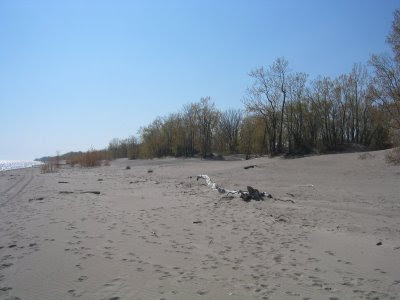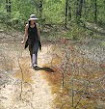I was helping someone design a native plant garden on their bare-ass new property. First we figured out her physiography, current and historic land use, and then tried to ID the area's historic natural heritage through historic and current records and surveys. Some times that's all it takes to figure out a site-appropriate native plant community model.
Historically her yard was likely a bottom land forest on a clay lake plain, and a riparian flood zone too. Problem was, the water had long since been drained (extensive network of channels and dikes) and the area is now high value crop land and urban residential. What do you do with that kind of clay when the water processes are gone?
Further complication: species from her historic plant community that we could still use on the site included ashes, butternut and white elm... not safe bets anymore, and other trees like sycamore and silver maple were too big for the fragmented space of her residential yard.
At that point the garden design and plant selection changed from a strict historic restoration plant community model into something called "reconciliation ecology": we were trying to figure out a unique native plant community appropriate to the realistic possibilities of that land, that would still support the area's biodiversity, natural heritage (including wildlife: native pollinators and birds), conservation and stewardship. In this particular case, it came right down to anything ethically locally sourced that would grow in her light, soil and moisture. There would be a lot of mulch involved too. BTW: we wanted to stay extra locally sourced because there are indigenous prairie species restoration projects on a sand plain that begins only one concession away / don't want to genetically swamp them with plants sourced from 500+ km's away. And the woodies would be local and Forest Gene Conservation Association (FGCA) certified, of course.
I told her "Actually, this can be some interesting and creative stuff." And then I reassured her "don't worry, your yard is not an asshole, and it's not going to be one."
However, if you ever need a graphic illustration of how quickly and dramatically someone can asshole-ize a yard with a garden, here's a fresh example.
Meters away on that same beach, is this recently landscaped yard:
Look again at those two pictures, even click through to enlarge them if you want to.
[Ok, in its own right, and just to fill your soul, especially check out those sweet, sweet dunes: the logs beached from the winter's ice (seems to me they're a happy spot for Fowler's Toads); the wee young cottonwood foot dune starting up near the shore (lower lake levels in recent years, and good littoral zone nutrients: for example in the dross you could see that the smelt still run in early May, though not like they used to up to about 1980); the swale developing between that foot dune and the established mature foredunes: being a big fan of mature interdunal meadows, I can hardly wait to see what the pioneer plant species will be in that swale. I could spend a warm month here with little more than a pup tent and wake up and fall asleep amazed every day just watching all of those processes functioning and the good plants still naturally finding footholds where they should. BTW: what make the resiliency of the landscape in this picture even more impressive to me is that it's not even a restricted area, it's a public beach. But, yeah, back to point of this yard...]
Except for the few cottonwoods they kept to left of their house the place is not only difficult to recognize, it's now an entirely changed ecological function and habitat.
At first I laughed. Then I was angry. I even cried.
For all I know these are decent people, the kind you could trust with your keys, car, cat, kid and a wallet. But yup, their new yard is an asshole. Not just what's been removed and displaced, but what's been introduced: exotic artemesia a few feet away from healthy wormwords; turfgrass species feet from big bluestem and switchgrass. It's not the more popularly recognized asshole yard of the "neglected" / weedy variety, or "what people have to do to survive" or "before anyone knew better". Instead it's one of those deliberate rapid succesions from a healthy local landscape (biodiversity) to "this place could be anywhere" asshole-of-the-misguided-garden-magazine variety. The kind that take significant money, resources, inputs, effort and planning to design, "install" and maintain.
And even if that part of the dunes is "zoned" residential, that justifies nothing. In fact it would only serve to illustrate what a dumb instrument an old zoning bylaw can be.
In fact, that entire dunes area is part of the Long Point UNESCO biosphere reserve (you would have to be occupied trying to not drive over a crossing turtle to miss that sign along the causeway), and the Long Point Basin Land Trust (super accessible and knowledgable folks who publish and present practical public education) area too. Also, their closest retail nursery? Not one but TWO major native plant nurseries (Acorus and Pterophylla) with suites of affordable indigenous dunes species = folks would literally have to go out of their way to buy non-native plants. All of which makes makes me wonder what the hell does it take to appeal to reason?
It's not just that I love our great lakes ecology, and that specific area's dunes vegetation and don't want to see it invaded and destroyed by exotic horticultural species, I actually saw a Fowler's Toad there a few summers ago.
Don't want your yard to be an asshole? Go for native, even indigenous plants and seeds if you can ethically source them. For more local criteria and context, suss out your local Land Trust, Conservation Authority or municipality and what they already have for current and historic natural heritage inventories (e.g. vegetation, wildlife, physiography, hydrology) and conservation, stewardship & natural systems management initiatives and strategies. The links on the right are a starting place for that. And the process of becoming literate with your own landscape's ecology has got to be more than half the fun of having a garden.



3 comments:
It's like people can't see a house as complete until it has grass around it, no matter how out-of-place that grass is.
By the way, I'm a fairly new reader and really enjoying your take on all this and the obvious expertise.
Nice article, though a bit depressing. Maybe you could so some guerrilla gardening on the property late some moonless night.
I Love your article...so well written and ringing so true. Thanks for writing it. Can I use your "Asshole" reference to bad landscaping or is it copyrighted?
Post a Comment